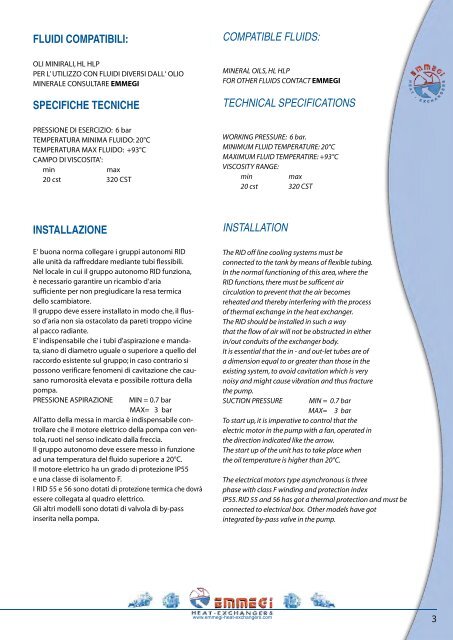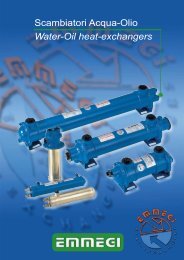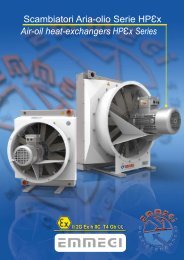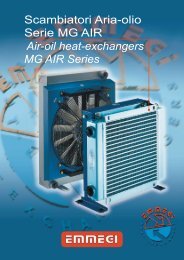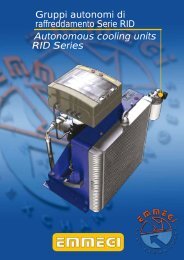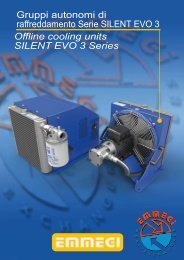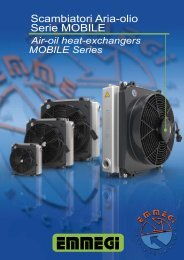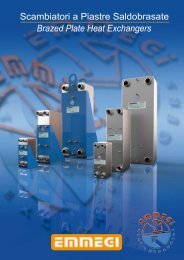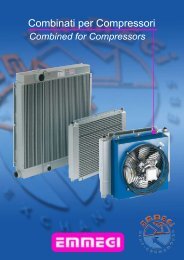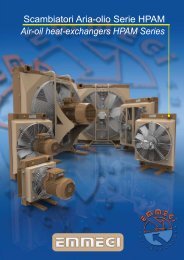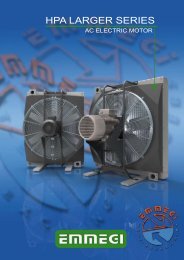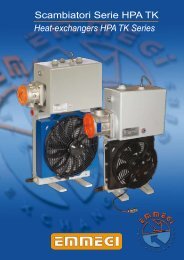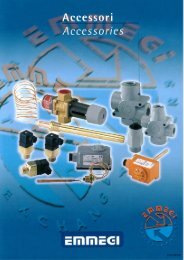9_Autonomous cooling units RID Series
Create successful ePaper yourself
Turn your PDF publications into a flip-book with our unique Google optimized e-Paper software.
FLUIDI COMPATIBILI:<br />
COMPATIBLE FLUIDS:<br />
OLI MINIRALI, HL HLP<br />
PER L’ UTILIZZO CON FLUIDI DIVERSI DALL‘ OLIO<br />
MINERALE CONSULTARE EMMEGI<br />
SPECIFICHE TECNICHE<br />
MINERAL OILS, HL HLP<br />
FOR OTHER FLUIDS CONTACT EMMEGI<br />
TECHNICAL SPECIFICATIONS<br />
PRESSIONE DI ESERCIZIO: 6 bar<br />
TEMPERATURA MINIMA FLUIDO: 20°C<br />
TEMPERATURA MAX FLUIDO: +93°C<br />
CAMPO DI VISCOSITA’:<br />
min<br />
max<br />
20 cst 320 CST<br />
WORKING PRESSURE: 6 bar.<br />
MINIMUM FLUID TEMPERATURE: 20°C<br />
MAXIMUM FLUID TEMPERATIRE: +93°C<br />
VISCOSITY RANGE:<br />
min<br />
max<br />
20 cst 320 CST<br />
INSTALLAZIONE<br />
E‘ buona norma collegare i gruppi autonomi <strong>RID</strong><br />
alle unità da raffreddare mediante tubi flessibili.<br />
Nel locale in cui il gruppo autonomo <strong>RID</strong> funziona,<br />
è necessario garantire un ricambio d’aria<br />
sufficiente per non pregiudicare la resa termica<br />
dello scambiatore.<br />
Il gruppo deve essere installato in modo che, il flusso<br />
d’aria non sia ostacolato da pareti troppo vicine<br />
al pacco radiante.<br />
E’ indispensabile che i tubi d'aspirazione e mandata,<br />
siano di diametro uguale o superiore a quello del<br />
raccordo esistente sul gruppo; in caso contrario si<br />
possono verificare fenomeni di cavitazione che causano<br />
rumorosità elevata e possibile rottura della<br />
pompa.<br />
PRESSIONE ASPIRAZIONE<br />
MIN = 0.7 bar<br />
MAX= 3 bar<br />
All’atto della messa in marcia è indispensabile controllare<br />
che il motore elettrico della pompa con ventola,<br />
ruoti nel senso indicato dalla freccia.<br />
Il gruppo autonomo deve essere messo in funzione<br />
ad una temperatura del fluido superiore a 20°C.<br />
Il motore elettrico ha un grado di protezione IP55<br />
e una classe di isolamento F.<br />
I <strong>RID</strong> 55 e 56 sono dotati di protezione termica che dovrà<br />
essere collegata al quadro elettrico.<br />
Gli altri modelli sono dotati di valvola di by-pass<br />
inserita nella pompa.<br />
INSTALLATION<br />
The <strong>RID</strong> off line <strong>cooling</strong> systems must be<br />
connected to the tank by means of flexible tubing.<br />
In the normal functioning of this area, where the<br />
<strong>RID</strong> functions, there must be sufficent air<br />
circulation to prevent that the air becomes<br />
reheated and thereby interfering with the process<br />
of thermal exchange in the heat exchanger.<br />
The <strong>RID</strong> should be installed in such a way<br />
that the flow of air will not be obstructed in either<br />
in/out conduits of the exchanger body.<br />
It is essential that the in - and out-let tubes are of<br />
a dimension equal to or greater than those in the<br />
existing system, to avoid cavitation which is very<br />
noisy and might cause vibration and thus fracture<br />
the pump.<br />
SUCTION PRESSURE MIN = 0.7 bar<br />
MAX= 3 bar<br />
To start up, it is imperative to control that the<br />
electric motor in the pump with a fan, operated in<br />
the direction indicated like the arrow.<br />
The start up of the unit has to take place when<br />
the oil temperature is higher than 20°C.<br />
The electrical motors type asynchronous is three<br />
phase with class F winding and protection index<br />
IP55. <strong>RID</strong> 55 and 56 has got a thermal protection and must be<br />
connected to electrical box. Other models have got<br />
integrated by-pass valve in the pump.<br />
www.emmegi-heat-exchangers.com<br />
3


